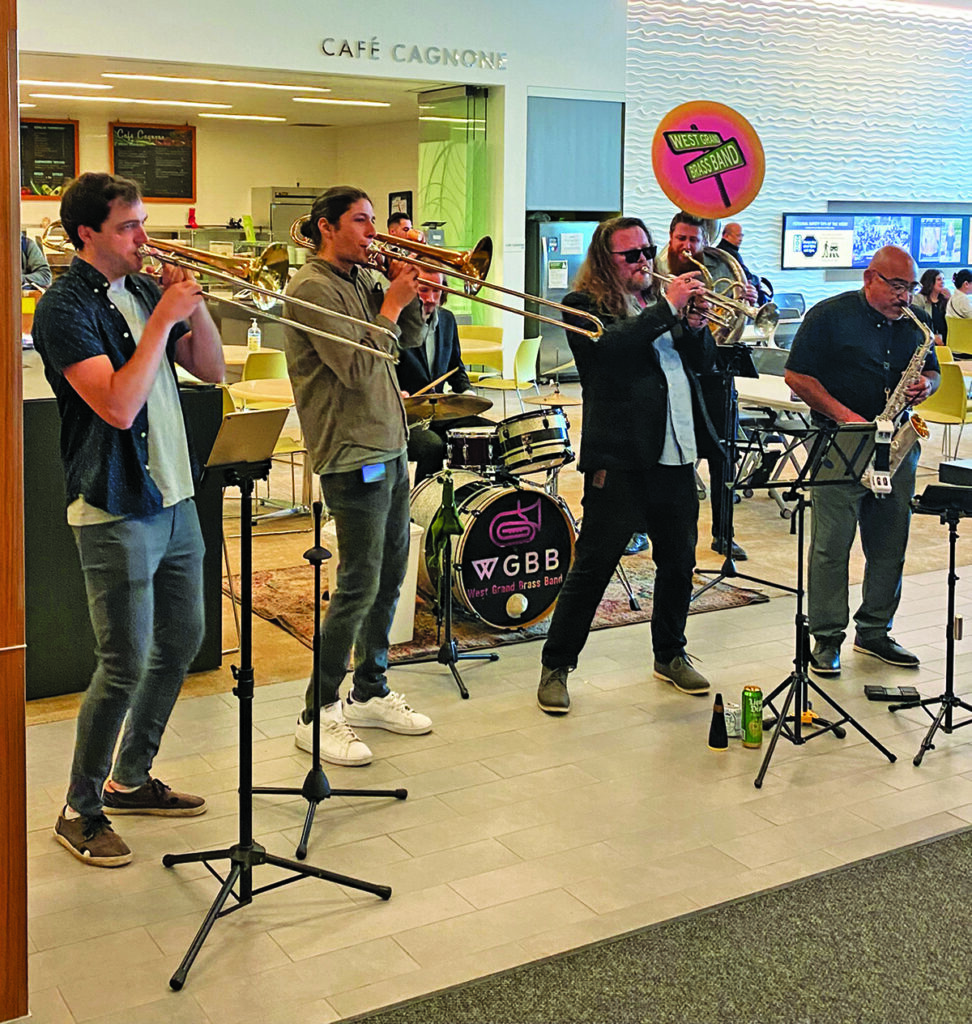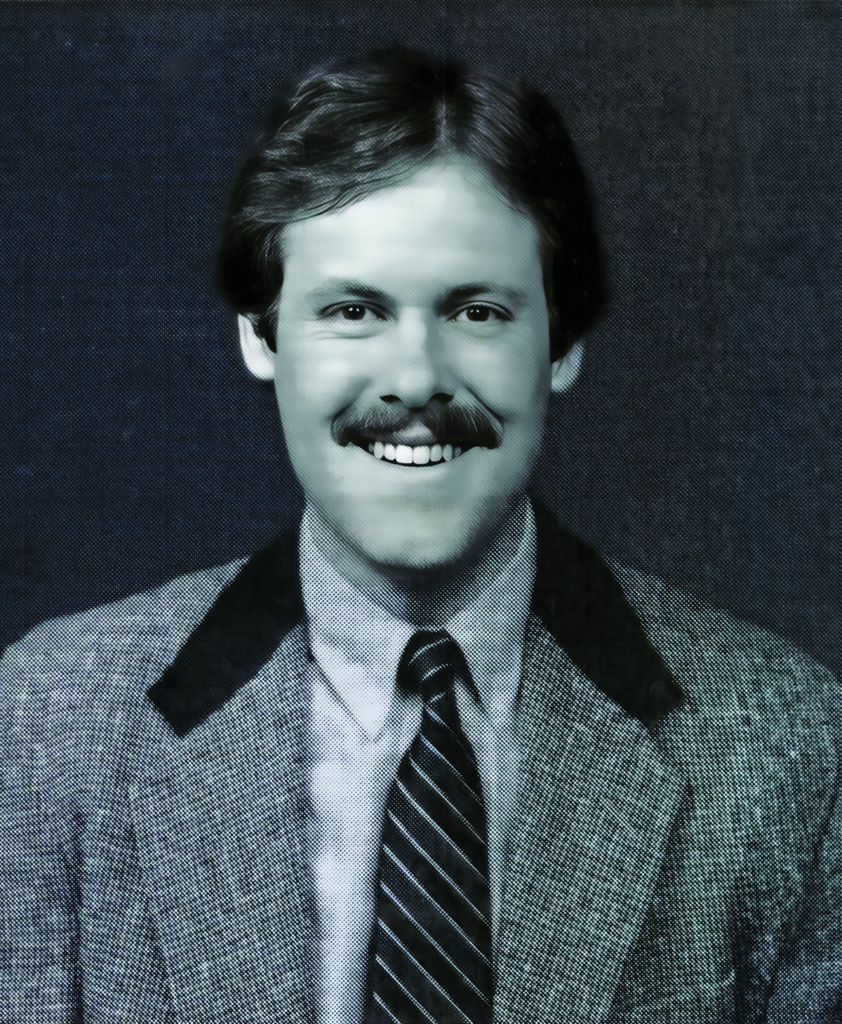By Dr. Eric K. Curtis ’85

Photos by Jon Draper
Forty-one years ago, in early July, an 18-hour drive from Arizona brought my dad and me to a gray clapboard apartment building on the corner of Sacramento and Laguna Streets in San Francisco. I flung open the door of my tiny rental trailer and dragged out a well-worn couch. Muscling its bulk across the sidewalk and into the lobby, I upended the couch and, pivoting from corner to corner, walked it over the linoleum into the quivering elevator. I squeezed in, crouching, and punched the button to the top floor. My transformation from college kid to dentist lurched into motion.
Entering the dental school’s orbit prompted a cascade of social activity, seemingly as natural and predetermined as the steps in the Krebs cycle. My new roommate Derrek, who picked me out of a list and cold-called me with a pitch to share his space, knew lots of people, including a third-year student who drove us to Tiburon for lunch the day before school started. We soon took in a third roommate named Armel (with whom I conferred several times as I prepared this article) and joined groups of students who gathered at the Presidio to watch Fourth of July fireworks and met for dinner at a Japantown restaurant called San Wang.
The dental school conducted its own rituals of inclusion. We sat for photos, welcome speeches and orientations. The admissions director, a jovial former U.S. Coast Guard officer named Dave Adkins, announced he would host a monthly group birthday party with cake. We each got a locker, a daunting stack of textbooks and a black buckram box containing a human skull.
We opened our first-year kit in the preclinical lab, guided by the resonant radio voice of Professor of Preventive and Restorative Dentistry and former Executive Associate Dean Robert Christoffersen ’67, where we unwrapped handpieces—it felt almost sacred to be granted access to such powerful professional talismans—along with an array of instruments carrying curiously personal names, particularly the ones for carving wax: PK Thomas, Hollenbeck, Tanner. “You don’t know what this is now,” Christoffersen intoned, again and again, holding aloft, in each instance, an exemplar, “but you will soon.”
I got to know my classmates, particularly the folks in my corner of the lab. One of them, Damon, who sat across the aisle, became a periodontist and has provided specialty care in my general practice—one day a week now—for 36 years. The school assigned me a “big sister” named Margaret from the class ahead. Another second-year student named Ed also dispensed helpful advice and an occasional cold soda as I slaved over my hot Bunsen burner.
Dean Arthur Dugoni ’48 explained his notions of a humanistic education—that students are actual people, worthy of respect. He told us to expect collaboration and collegiality, rather than the hazing considered normal in other dental schools, from our instructors, who would from the outset call us “doctors.” At the end of the week, Dean Dugoni invited the entire incoming class to his home down the peninsula—his actual house, as if we were family, or something—for swimming and a barbecue.
On the third weekend, the administration loaded us onto buses and sent us to Stockton, where we became acquainted with Pacific’s mother ship, participating in discussion groups and hanging out poolside. The school’s warm embrace, which, as the dean promised, included a noticeably supportive stance from faculty and staff, really did help ease me into the intensity of my new environment. My journal entry on August 15, 1982 reads, “In operative lab, Dr. Savio always says ‘redo’ so nicely.”

West Grand Brass Band 
Dr. Eric K. Curtis ’85 in the CHIPS yearbok 
Ryan Zarrabian, Class of 2025, with Pacific’s Powercat mascot. Photo by Ryan Zarrabian
The initiatory events I recall remain notably intact—welcome speeches, photos, mixers, student mentors and even an off-campus excursion. As we did, current students mingle even before classes start. Kalene Ward, Class of 2026 and a member of the Diversity and Inclusion Committee, says class members met informally the weekend before school to get to know each other, “which helped take the edge off first-day jitters because we had already made a few friendships by then.”
Although the hand instruments so prominent in my kit occupy a diminished place, and handpieces reside in sterilization areas, students still assemble in the sim lab to open their first-year kits, an occasion that Assistant Dean of Admissions, Student Services and Diversity Stan Constantino calls “the pinnacle of the week.”
The pinnacle crowns a more action-packed week, and month, than ever. Honoring the school’s traditions and embracing its ethos, Constantino’s Office of Student Services crafts a comprehensive slate, updated yearly, of opening ceremonies, thoughtfully selected, strategically arranged, tightly organized, fine-tuned and polished to a shine. “The Dugoni School has upheld its long-standing traditions, which is remarkable,” Constantino says. “Dean Nadershahi has shared his vision of maintaining storied traditions and also urged us to create new ones.” Accordingly, “We also have participated in and re-imagined new and refreshing traditions.”

Alumni Association-catered Cioppino Dinner 
Dr. Leo Makhdoom, IDS Class of 2025, at kit opening 
Student services team ready to welcome students
Dean Nader A. Nadershahi ’94 says that matriculation exercises endeavor to focus students on their new identity, as faculty and administrators outline expectations and offer avenues for success, both in school and in life. “We want students to understand the culture of the Dugoni School, as well as of the profession itself,” he says. “We tell them the integrity of our profession is in their hands.”
“We want students to understand the culture of the Dugoni School, as well as of the profession itself”
Constantino believes that the first day of school should be just as memorable and essential as graduation. “I challenged my staff to help create memories and foster a sense of community, support and belonging for our students,” he says, citing evidence demonstrating that a student’s feelings of affiliation protect mental health and boost academic outcomes.
Armed with these sensibilities, the student services staff churns out a lineup of celebratory features wholly lacking in my day. On the first day this year, students, faculty and staff arrived on campus to the sounds of a live brass band playing top-40 pop music. They entered the building, accompanied by the university’s Powercat tiger mascot, under a balloon arch, to find inside a continental breakfast and photo booth.

Students getting acquainted in Molinari Hall 
Students from the Class of 2026 at the Meet the Fam event 
Dr. Mark Booth ’01 with new students at Meet the Fam
Students report both astonishment and reassurance. Christian Aquino, Class of 2026 president, describes a “rousing welcome orchestrated by a spirited marching band.”
Radhika Ruparel, IDS Class of 2025 vice president, says, “We felt at home the first day itself when we were welcomed with a band and smiling faces.”
“On our first day of school there was a giant welcome party, which made me feel appreciated and excited,” says Class of 2026 Ethics Representative Brandon Alexis.
Matriculation week activities carefully balance the noise with nuance, offering both a “Meet the Fam” reception, in which new students mix with faculty and staff, and a First-Gen Lunch for students who are first-generation college graduates, where they mingle with faculty who are also first-gen grads.
Entering students receive presentations on diversity, equity and inclusion; laptop orientations with the IT division; introductions to building operations, financial aid and the school’s medical clinic and wellness center; and information about counseling and psychological services, student leadership opportunities, public safety and the integrated clinical sciences curriculum. This year’s off-site, first-year retreat included team-building exercises, discussions of achievement-promoting strategies and a keynote address on professionalism.

Students emjoying the Exploratorium 
Students activate the “Colored Shadows” exhibit at the Exploratorium. Photo by Samina Nguyen 
The traditional kit opening… 
…in the simulation lab
Admittedly a lot to absorb, such rapid-fire exposures to Dugoni School life are designed to boost students into high-energy mode. “The first week of school was very insightful.” Alexis says, “It prepared me for the rigorous schedule ahead.”
“We’re lucky to have incredible people at our school, both our students and those who support them and the future of our school.”
The school also goes out of its way to entertain. This year’s entering students enjoyed an excursion to the Exploratorium, along with a battery of breakfasts, lunches, snacks and hors d’oeuvres, capped by the now-famous Alumni Association-catered Cioppino Dinner.
“Our goal is to keep students engaged,” says Janelle Palomares, manager of student life and involvement. “We do our best to make our presentations interactive and fun.”
“Creating learning environments and co-curricular experiences for our students has always been at the heart of our department,” Constantino explains. “Our dedication and beliefs about higher education serve as the foundation of our commitment to the development of not only a doctor, but the ‘whole person.’”

First-day fun in the photo booth 
New students are all smiles
An awareness that sociality enhances holistic growth runs through all levels of engagement. Aquino, who discerns in matriculation activities “a pervasive atmosphere of motivation to propel us towards our goals,” also appreciates that cooperation underlies achievement: “Having classmates always ready to offer guidance and assistance made adapting to the fast-paced program more manageable.” Ward agrees: “You cannot do dental school alone.”
Mutual acceptance is critical. “We want to create an atmosphere in which everyone feels comfortable, where no one has to worry about being who they are,” Dean Nadershahi says.
Nadershahi emphasizes that education must concentrate as much on its participants as it does on the curriculum and physical plant. “We’re lucky to have incredible people at our school, both our students and those who support them and the future of our school.”
“Creating learning environments and co-curricular experiences for our students has always been at the heart of our department.”
Luck seems to follow thoughtful planning and deep wells of goodwill. “We want the students to be comfortable in their new home,” Palomares says. “We are a family, and we want them to succeed.”
The attention to hospitality and fellowship makes the same magic I remember. “The unwavering support and camaraderie this institution offers are unparalleled in the world of dental education,” Aquino says. “The Dugoni School truly embodies what it means to be a family.”
Eric K. Curtis ’85, DDS, of Safford, Arizona, is a contributor to Contact Point and is the author of A Century of Smiles, a historical book covering the dental school’s first 100 years.

Photo by Benjamin Levy